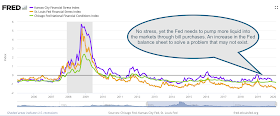First questions you ask for problem solving: "What is the problem to be solved?" Who has the problem?"
So, what is the problem that is being solved with the massive purchase of Treasury bills by the Fed each month. The Fed works under a dual mandate of growth and stable inflation. In this capacity, they will serve as the lender of last resort in a crisis and provide for financial stability to help reach the dual mandate. Financial stability may be the third implicit mandate.
If there is financial stress, then the Fed may want to take action relieve the stress that may spill-over to the real economy. However, the measures of financial stress from the St Louis Fed and the Kansas City Fed are at or near all time lows. The Chicago Fed Financial Conditions Index is also near all-time lows and has been very stable. All are well below their constructed averages.
Financing congestion and a spike in repo can have externalities on Treasury and short-term financing, but there has been now an extended repo program since September and a massive monthly buying program of $60 billion per month. This type of activity would suggest a massive financial stress problem.
This expected or perceived stress does not exist in the index numbers. It did not exist before September and does not exist today. There was a heightened level in December of 2018, but the lowering of rates seemed to have solved that problem. If the data indices are wrong or flawed, then they should be dropped. If they are useful, then policy-makers should at least take heed of their levels.
Regulation and technical issues were the drivers of the repo and a solution of throwing money at the problem is not a fix. What kind of Fed guidance is given to the market when it is inconsistent their data? We have seen the result of Treasury bill buying, spiking of financial asset pricing. Once the buying subsides, we should know what will happen.


No comments:
Post a Comment